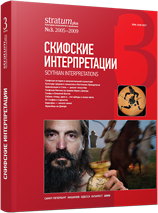Антропоморфные изображения в меото-скифской торевтике
Anthropomorphic Images in Meotic-Scythian Toreutics
Author(s): Anatoliy R. Kantorovich, Vladimir R. ErlichSubject(s): History, Archaeology, Cultural history, Ancient World
Published by: Издательский дом Stratum, Университет «Высшая антропологическая школа»
Summary/Abstract: The authors study anthropomorphic motifs in the art of Meotic tribes of Kuban’ in the Scythian epoch. Although the anthropomorphic features are not numerous, with the beast style having absolute domination, the Meotic art in this period gives bright images – both solitary and in compositions, including in scenes with zoomorphic characters. At the same time, some works found on sites of Meotic culture are products of other art systems, first of all the Ancient Greek art. In some cases they are little connected with the Meotic cultural context, while in some other cases they decorated elements of the local costume (golden sewn-on badges) and harness of the Meotic culture (bronze badges). Besides, the style of some separate anthropomorphic images (each dated within 4th c. BC) representing the hero-warrior and the cult of the dead human head, fully corresponds to the traditions of Meotic or Meotic-Scythian art, or is a combination of elements of the local art with features of some other art systems.Thus, although the anthropomorphic images in Meotic art of Scythian epoch are not numerous, this topic (sometimes in close connection with zoomorphic images) was reflected in some bright images and scenes in the works of the local toreutics in 4th c. BC. This was encouraged by Scythian art as well as by the respective rich motifs in Ancient Greek, Thracian and Celtic art, which sometimes had a direct and sometimes indirect impact on the culture of Meotic tribes in Kuban’.
Journal: Stratum plus. Археология и культурная антропология
- Issue Year: 2009
- Issue No: 3
- Page Range: 277-296
- Page Count: 20
- Language: Russian
- Content File-PDF

